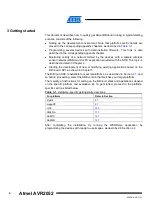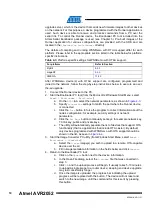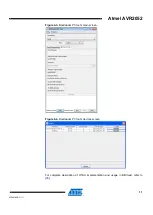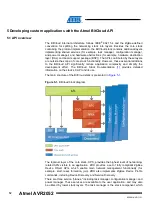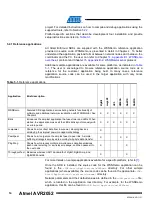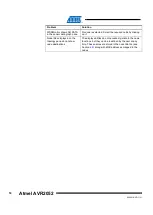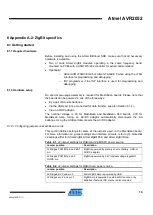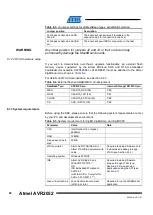
Atmel AVR2052
5
8200M-AVR-11/11
4 WSNDemo application
4.1 Overview
The network and radio frequency performance of the hardware components is
demonstrated with the WSNDemo application, which is based on the Atmel BitCloud
API. This application consists of the embedded firmware, which supports functions for
coordinator, router, and end device, and the GUI visualization application,
WSNMonitor, which is run on a PC. In WSNDemo, the nodes communicate based on
a proprietary messaging protocol.
The SDK includes the WSNMonitor PC application in binary format, and the
WSNDemo embedded application is available in binary format and source code.
The source code for the WSNDemo application can be modified and extended,
making it possible to develop WSN applications for a variety of application scenarios.
WSNMonitor is described in Section
. Some more details on WSNMonitor and
With WSNDemo installed, the devices are organized into a set of nodes forming a
ZigBee PRO network.
With Atmel ZigBit development boards, end devices, routers, and the coordinator
read the sensor data from onboard light and temperature sensors, and forward
collected data to the WSNMonitor application for visualization. On Atmel XMEGA,
Atmel SAM7X, Atmel SAM3S, Atmel megaRF, and Atmel UC3 platforms, zero values
are sent to the network coordinator to emulate sensor data and demonstrate data
transmission.
End devices follow a duty cycle (that is, the microcontroller and radio transceiver are
put to sleep periodically) and wake up to transmit data to the coordinator. Using the
serial connection, the coordinator transmits the received packets, along with its own
sensor data (or emulated sensor data), to the WSNMonitor application. Those
transmitted values are displayed on WSNMonitor panes as temperature, light, and
battery level measurements.
WSNMonitor also visualizes network topology by drawing a tree of nodes that have
joined the network. For each of the nodes, parameters like node address, node
sensor information, and link quality data are displayed.
RSSI indicates a link’s current condition and is measured in dBm. The RSSI
resolution is 3dBm.
LQI,
a numeric parameter defined within the 0 to 255 range, is
used to measure the link quality. Larger values mean a better link, while values close
to zero indicate a poor connection.
In WSNDemo, the number of routers and end devices is limited only by the network
parameter settings.
In reference to the WSNDemo application, Section
use the boards. The user interface is described in Section
The application is delivered with source code that demonstrates how to develop a
wireless network application using the Atmel BitCloud API, and provides a number of
useful programming templates for common application tasks. Development of custom




